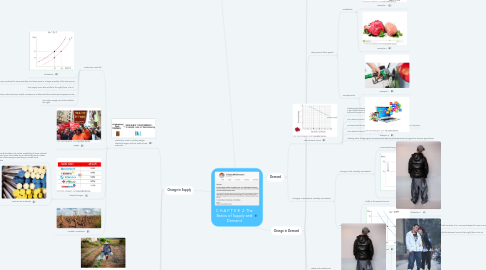
1. Suppy
1.1. The Supply Curve
1.1.1. Relationship between the quantity of a good that producers are willing to sell and the price of the good.
1.1.2. The supply curve, labeled S
1.1.3. S in the figure, shows how the quantity of a good offered for sale changes as the price of the good changes.
1.1.4. The supply curve is upward sloping
1.1.5. The higher the price, the more firms are able and willing to produce and sell.
1.2. Changes in Supply & Quantity Supplied
1.2.1. Change in Supply
1.2.1.1. refer to shifts in the supply curve
1.2.1.2. Example
1.2.1.2.1. If production costs fall, firms can produce the same quantity at a lower price or a larger quantity at the same price.
1.2.1.2.2. The supply curve then shifts to the right (from S to S′).
1.2.2. Change in the Quantity Supplied
1.2.2.1. movements along the supply curve
1.2.2.2. Example
2. Change in Supply
2.1. Production costs, including wages, interest charges, and the costs of raw materials.
2.1.1. Production costs fall
2.1.1.1. Illustration
2.1.1.2. If production costs fall, firms can produce the same quantity at a lower price or a larger quantity at the same price.
2.1.1.3. The supply curve then shifts to the right (from S to S′).
2.1.1.4. When production costs decrease, output increases no matter what the market price happens to be.
2.1.1.5. The entire supply curve thus shifts to the right.
2.1.2. Wages
2.1.3. Interest charges
2.1.3.1. Easy credit facilities such as the availability of lower interest loans and more favourable terms offered by banks makes the cost of borrowing or spending on credit more attractive
2.1.3.2. Costs of raw materials
2.1.4. Weather Conditions
2.2. Technological Advances
2.2.1. Old technology
2.2.2. New technology
2.3. Changes in the Government Policies
2.3.1. The imposition of indirect taxes and granting of subsidies will bring about changes in supply. An indirect tax imposed on a good increase the cost of supplying that good.
2.3.2. Subsidies have the opposite effect- they lower the cost of production and supply is increased, thus shifting the supply curve to the right.
2.4. Number of suppliers (S)
3. Demand
3.1. The Demand Curve
3.1.1. Relationship between the quantity of a good that consumers are willing to buy and the price of the good.
3.1.2. The demand curve, labeled D
3.1.3. D shows how the quantity of a good demanded by consumers depends on its price.
3.1.4. The demand curve is downward sloping
3.1.5. holding other things equal, consumers will want to purchase more of a good as its price goes down.
3.2. Changes in Demand & Quantity Demanded
3.2.1. Change in the Quantity Demanded
3.2.1.1. Movements along the Demand curve
3.2.1.2. Example
3.2.2. Chage in Demand
3.2.2.1. Shifts in the Demand curve
3.2.2.2. Example
3.2.2.2.1. If the market price were held constant at P1, we would expect to see an increase in the quantity demanded—say, from Q1 to Q2, as a result of consumers’ higher incomes.
3.2.2.2.2. A higher income level shifts the demand curve to the right (from D to D′).
4. Change in Demand
4.1. income
4.1.1. Higher income (Normal goods)
4.1.1.1. Illustration
4.1.1.2. A higher income level shifts the demand curve to the right (from D to D′).
4.1.1.3. If the market price were held constant at P1, we would expect to see an increase in the quantity demanded—say, from Q1 to Q2, as a result of consumers’ higher incomes.
4.1.1.4. Because this increase would occur no matter what the market price, the result would be a shift to the right of the entire demand curve.
4.1.2. Higher income (Inferior goods)
4.2. Weather
4.2.1. The demand for many goods and services such as clothing, food, water,healthcare and travel are influenced by seasonal conditions.
4.3. The prices of other goods
4.3.1. Substitutes
4.3.1.1. Example 1
4.3.1.2. Example 2
4.3.2. Complements
4.3.2.1. Example 1
4.3.2.2. Example 2
4.4. Tastes and Preferences
4.4.1. 8x & 9x
4.4.1.1. Illustration 1
4.4.1.2. Illustration 2
4.4.1.3. Illustration 3
4.4.1.4. Illustration 4
4.4.2. Consumer's tastes and preferences are influenced by current fashion peers, advertisements, pop-star appeal, age, gender, culture etc. Changes in consumers' tastes in favour of (or against) a good or service will increase (or decrease ) its demand as this would affect their buying patterns for the product.
4.5. Expectations of Future Price Changes
4.5.1. Illustration 1
4.5.2. The fear or expectation of a future price increase will induce consumers to buy more now so as to maximise per additional dollar spent, thus increasing demand for the good concerned.
4.6. Change in the Government Economic Policies
4.6.1. Illustration 1
4.6.2. Anti-smoking Campaigns
4.7. Availability of credit facilities and hire purchases
4.7.1. Easy credit facilities such as the availability of lower interest loans and more favourable terms offered by banks makes the cost of borrowing or spending on credit more attractive
4.7.2. Less stringent hire purchase terms will allow more consumers the ability to buy the products now, thereby increasing demand for goods

